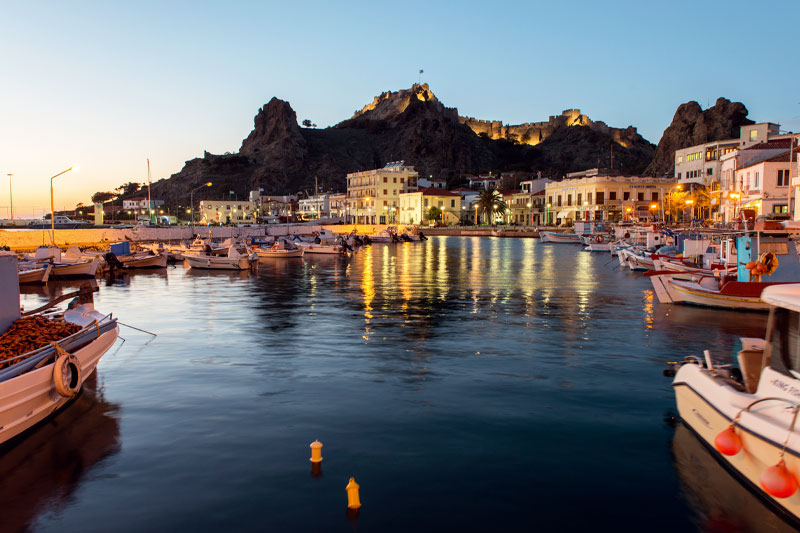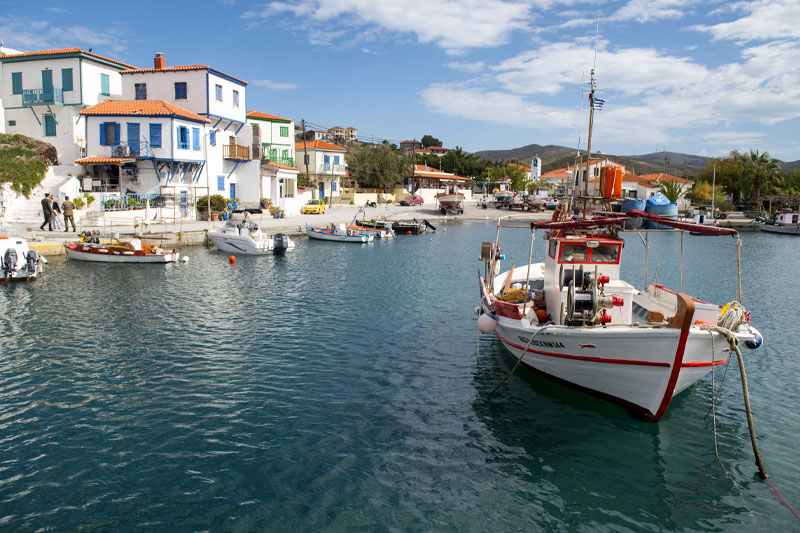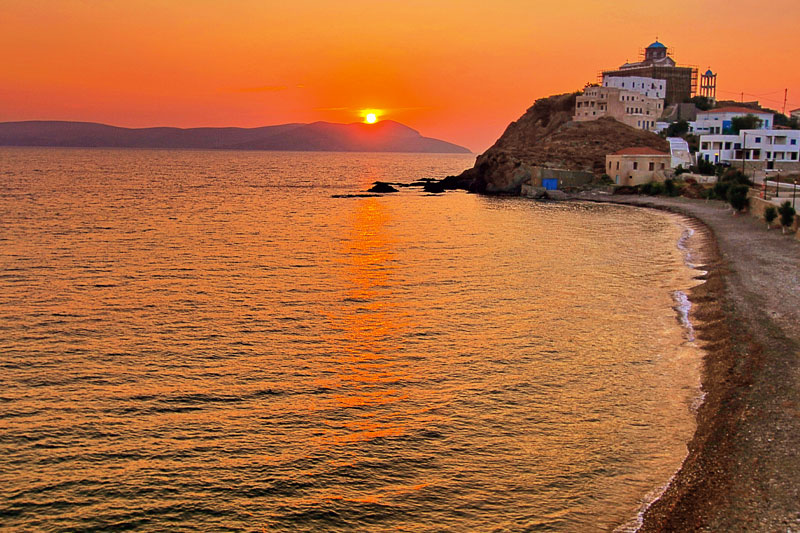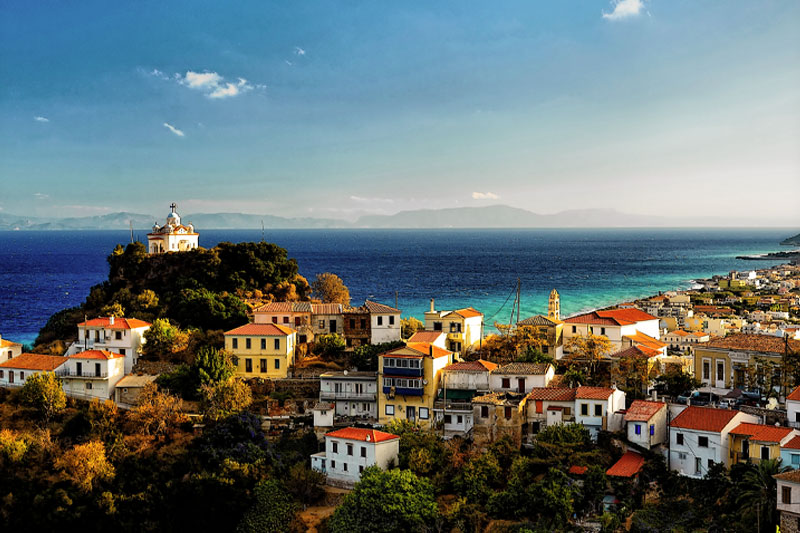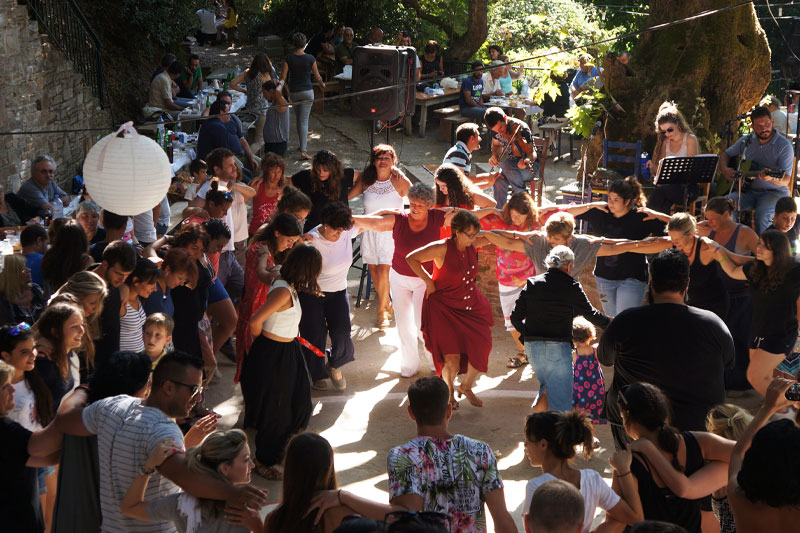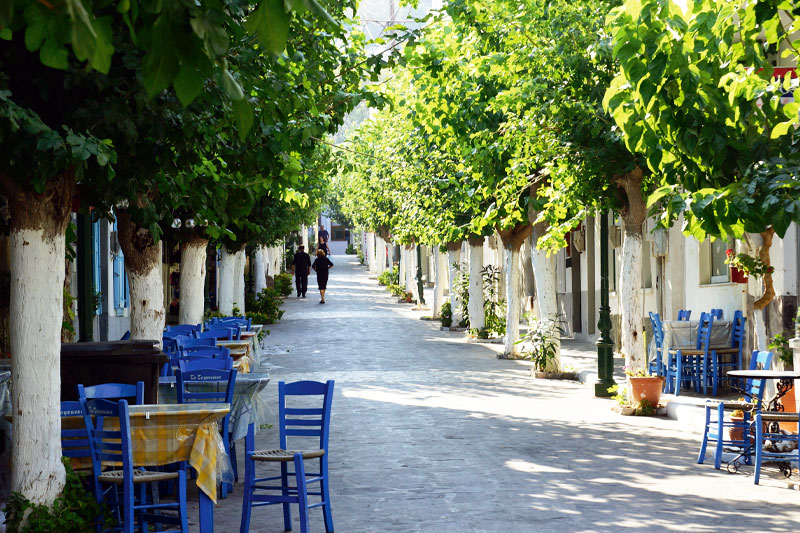Explorations
Lesvos – hidden harmony
A place of alternations
Lesvos, an island of colors and contrast, is a rich green heavenon earth, with a mild and temperate climate, rich soil andabundant in water. The endless olive groves, pine forests,oaks, walnut trees and rare flora, as well as the unique volcaniclandscape of the western side of the island, with thepetrified forest, compose its outdoor beauties and there isno dispute that you will immediately feel like exploring.The entire island of Lesvos has been incorporated as aGeopark in the UNESCO Global Geopark Network. On theisland there are three protected areas which belong tothe European NATURA 2000 Network: ‘Geras Gulf and Mt.Olympus’, ‘Kalloni Gulf Wetlands’ and the ‘Petrified Forest -Western Peninsula’.
Petrified Forest
To the west, in the area of Sigri, lies the Petrified Forest.The climate here becomes dry, while the rocks are volcanic.Upon closer inspection one can recognize an enormousvariety of plants and animals. Plant fossils can be observedamidst volcanic rock. These fossils are the world renowned‘Petrified Forest of Lesvos’, which covers an area of 15,000hectares. Several fossil sites of great interest have beenrecorded in the area, with clusters of tree trunks and impressivevolcanic habitats, resulting from volcanic activity in thearea some 20 million years ago. For this reason, the PetrifiedForest could be characterised as an open window on thegeo-historic evolution of the Aegean over the last 20 millionyears. The Petrified Forest is a unique forest ecosystem thatwas petrified due to intense volcanic activity. The greatnumber of standing petrified trunks and root systems in fulldevelopment, prove its indigenous nature.
Hot springs and waterfalls
In the Gulf of Geras you will find the renowned Therapeutic Hot Springs, worth visiting during the winter months. Geological evolution changes have endowed Lesvos with a large number of therapeuticsprings of various chemical compositions and temperatures, which have been proven to treat various illnesses. Other significant therapeutic springs are those of Eftalou, Polychnitos, Lisvorioand the Loutropolis of Therme. A total of 14 waterfalls have been recorded on Lesbos in the following areas: Parakoila, Skoutaros, Vatousa, Mesotopos, Mandamados, Vasilika, Antissa and Pelopi. Thewaterfall of Krinelo in Eressos is the largest, while extreme sports (climbing, rappel, and flying fox) are organised at Man’katsa waterfall, with its enormous dark rocks, looming 15-20 meters high.
Limnos – mythical beauty
Hiking trails and caves
The exploration of Limnos’ wild naturestarts with some of the most impressive hikingroutes, such as the one leading to theChapel of Panagia Kakaviotissa. To reach therock on which the chapel is built, you willhave to cross the village of Thanos, startingfrom Evgatis beach.Near the Cabeiroi sanctum, at Kondopouli,you can visit the cave of Philoctetes, whichhas two entrances, one on the side of therock and one from the sea. According tomythology, during the first campaignagainst Troy, the Achaeans abandonedPhiloctetes, the hero in Sophocles’ tragedyof the same name, on Limnos and left forTroy, because a snake had bitten his leg,causing him great pains and causing aterrible odour to emanate from his wound.Philoctetes was left on the island for twelveyears, living in a cave, hunting for his foodusing Heracles’ weapons, and finding relieffrom the pains in his leg by applying Limniaearth.Other caves can be found in the inaccessiblearea of Megalo Fanaraki, near Moudros,where Limnos Petrified Forest lies.20 million years ago the entire island wascovered by forests of palm trees, pine trees,giant sequoias, until they were all coveredby volcanic lava.
Earth and water formations
To the east of Atsiki lies the area of Falakra, with impressive ores,weirdly shaped rocks and picturesque coves. To the west of Atsikivillage, beyond Daphne and Katalakko villages, one can discover theimpressive sand dunes. This is a sandy area, called by the locals ‘PachiesAmmoudes’ (Thick sand). The sand dunes can be reached at the end ofan impressive route through wild olive trees, astivia bushes (Poteriumspinosum) and asphodels along Gomati beach. These are important,fragile habitats, home to plants and animals that have adapted throughmillennia to such harsh environmental conditions. One of the island’shidden beauties is ‘Kremasta Nera’ (Hanging Waters), which is nearKaspakas village, in Katsaitis gorge. This waterfall is most enjoyableduring the rainy season. In the region of Kornos village lies the springof Therma, the only therapeutic spring on Limnos, at the foot of Mt.Profitis Elias, where the church to the prophet has been erected. Thetherapeutic spring, known since antiquity, lies on the edge of a major1200m geological fault. Its temperature is 42° C around the year. Thewater at Therma is potable and appropriate for both spa and drinkingtherapy, since it contains a minimal quantity of minerals.
Agios Efstratios – escape to nature
Favourite Itineraries
Agios Efstratios or Ai Stratis, as the locals call it, is an island ofunique natural wealth and beauty. Picturesque beaches, raregeological formations, and sea caverns compose the enchantingscenery, while the countless oak trees that decorate its beachesoffer their rich shade, a welcome coolness in the hot summer.Endless walks in nature and hiking trails amidst picturesque chapelsand historical monuments will pleasantly monopolise your holiday.Follow a network of approximately 50 kilometres and discoverthe island’s beauty through easily accessible dirt roads. In thenortheast part of the island, nature is dominant with a gloriousforest of uncultivated oak trees, while on the northwest side liesthe community of Agios Efstratios. In its beautiful small harbourfishermen moor their fishing boats; this is also the starting pointfor recreational vessels that tour around the entire island to reachthe beaches that are inaccessible by land routes. The most famousbeaches are Agios Dimitrios, Trygaris, Trypiti, Ftelio, Gournia andLydario.If you find yourselves on such a boat, you will have the opportunityto admire the rocky shoreline, where the sea caverns are located,an ideal sanctuary for Mediterranean seals (Monachus monachus).The steep coastal cliffs are home to predators (Eleonora’s Falcon)and other important sea birds (European Shag, seagulls, YelkuanShearwater), while rare plants can be found in spring lakes.The island is also of great interest to divers, as the meadows ofPosidonia (seagrass), also known as ‘Fykiades’, extend along itsseabed. The sea meadows of the Mediterranean seas providenesting and breeding grounds for a large number of sea species,while they contribute to the protection of shores from erosion.If you are a lover of underwater fishing, Dodeka Apostoloi,Daskalio and Velia are some of the richest islets in fish populations,guaranteed to attract your interest.Agios Efstratios belongs to the “NATURA 2000” network ofprotected areas, since it includes important land and sea habitats.
Chios – land of scents
Hiking routes
One of the most wonderful hiking routes endsat the lush canyon of Kampoi and its river, whichcan be turbulent depending on the season. Itis in northern Chios, near Mt. Pelinnaio, and anapproximately two and a half kilometre trail revealsto visitors the locals’ harmony with nature. Thecanyon is a forest of chestnut trees, sycamore trees,almond-leaved pear trees, small and perennialoak trees, pine trees and bushes, and it is a naturalrefuge for rare birds, such as the Long-leggedBuzzard, Bonelli’s Eagles and Eleonora’s Falcon.Next to the river there is a trail that leads to spotlessKampies beach, a place bursting with citrusgardens. On the way you will have the opportunityto admire the medieval castle of Oria and thechapel of Agia Paraskevi, both built at the top of anelevated rock.If you would like your excursion to becomemore historically interesting, Apolichni Castle, inArmolia village, in Southern Chios, is an impressive,wonderful destination. This is also perched on a hilland in order to visit it you have to follow an uphilltrail between dense burgeoning pines.Mesta and Olympoi are two medieval villages ofhistoric and architectural interest and the trailleading to the area passes through countless olivetrees and fragrant mastic trees. Along with Pyrgi,they are the oldest medieval communities in Greecethat have been inhabited without interruption.Other beautiful routes you can follow includehiking up to Kastro Grias (Old Lady’s Castle), takinga tour of Malagiotis Valley or a walk in renownedChios Campos (The Flatlands), with its beautifulcitrus tree groves.
Caves
Chios has a number of natural caves, the most important being the Olympoi cave andthe cave at Agio Galas, in southern and northern Chios, respectively. Some of these areunderwater and difficult to get to, and require special equipment in order to be explored.In the village of Agio Galas, in the area of Glyki Nero, you can observe and photographthousands of butterflies that create a magical image with their dance.
Oinousses – riches of the sea
Mini explorations
The Oinousses are a perfect holiday destination and their unique natural wealth has promoted the entire islandcomplex into a NATURA 2000 Network Protected Area.The island has beautiful small coves for swimming or fishing and the island’s low hills, valleys and groves are idealfor healthy walks along the island’s age old trails, affording a view over the Aegean.You will find tranquil beaches amongst lentisks, fig trees and vineyards, such as Bilali, Fasoli and the sandy beachof Apeganos, quaint beaches with crystal clear waters, such as Ai Giannis, Aspalothrocampos, Kalamiaris, Marmaro,Alyki, and others, harder to approach, such as Chochlakas and Katsika.Touring the island by caique is an unforgettable experience one should not miss at the Oinousses. Especially inwinter months, the rich flora and the rare toadstools and mushrooms attract nature lovers. Visit the neighbouringdesert islands, each of which has its own natural beauty and explore their virgin beaches.Most of the island’s beaches are perfect for water sports, such as diving and underwater fishing. The seabed’s richfauna attracts divers throughout the year, as it offers a revealing underwater experience.
Psara – trails of history
Endless blue
Psara is a retreat to bring you closer to nature. Follow the hiking trails and paths leading to the beautiful chapels and important historical monuments of the island.The island is renowned for its wonderful beaches with immaculate deep blue waters; there are beaches with pebbles, in closed coves, with fine sand, deserted, unexplored, relaxing, serene or comforting.The most popular one is Katsounis beach which, just like Kato Gialos, lies within the community. It is sandy with shallow waters and hosts the local beach volley tournament every summer,organised by the Psarianoi Brotherhood. Other beautiful beaches include Lazarepa with fine sand and seashells, Lakka and Limnos beach with its sand and fine pebbles.The numerous islets around the island are rich in fish and ideal for fishing. During your tour, visit the areas belonging to the ‘NATURA 2000’ protected network territory, which are habitats of naturalbeauty and need special protection. It is also worth visiting the islanders’ “paradise”, the neighbouring uninhabited island of Antipsara, with its amazing beaches and pristine waters.
Samos – the light of Pythagoras
Sea and Mountain
Samos is considered to be an island of incomparable beauty because it combines mountainous and marinesettings. Apart from singular beaches with crystal waters, its arsenal also includes lush mountains, hikingtrails, climbing courses, caves and canyons. More than 40 routes through dense pine forests offer a uniqueopportunity to enjoy the rich variety in the island flora and fauna. Enchanting tours along picturesquecobbled trails through forests, dewy ravines and quaint villages perched on mountain slopes, reveal theharmonious coexistence of man and nature.
Flora and Fauna
Mt. Kerkis and Mt. Ambelos – named after the numerous vineyards that existed there in antiquity -the twomajor mountains of Samos, are rich in trails and hiking routes for exploring. For lovers of adventure andnature, we recommend the trail that starts at Votsalakia -on the Marathocambos side- and ends at Vigla, thepeak of Mt. Kerkis, at an altitude of 1400 metres. Mt. Kerkis and Mt. Ambelos both present rich flora and arehome to more than 1400 species of indigenous and rare plants.
Bicycle ride
A good way to enjoy Samos nature and beaches is cycling. Follow the route from Kokkari and ride throughthe enchanting beaches of Lemonakia, Tsamados and Tsambos, and from there to Agios Konstantinos orKarlovasi.
Dips into the sea
Samos’ beaches, whether pebbled or sandy, are scattered all along the island’s coastline next to scenery oflush vegetation. Mikro Seitani and Megalo Seitani stand out for their fierce beauty and aquamarine waters.Megalo Seitani is the beach of the endangered Mediterranean monk seal (Monachus monachus) and alongwith the forests of Kastania and Lekka -on Mt. Ambelos- and cape Katavasi, these have been listed as SpecialProtection Areas incorporated in the NATURA 2000 Network.
Ikaria – alternative paradise
Hiking trails
If you love hiking and walks in the countryside theisland’s natural footpaths will reward you. You willmeet dense pine forests, wild waterfalls, streams,lush green valleys, stone bridges, beautiful lakesand picturesque villages. On the northwest side ofthe island lies the lake dam of Pezi, the lush greencanyon of Chalari and its turbulent river. Along yourhike you will encounter the Gemelia and Loupastraold stone bridges, Chalari’s waterfalls, a lake surroundedby dense vegetation and old traditionalwater mills. At a height of 45 metres, Ratso waterfallin Ano Chalari is an incredible sight worth seeingand then you can continue until you reach the picturesquelocation of Karkinagri. At the centre of theisland lies the ancient forest of Ranti with its age oldAries (a type of oak), rare herbs and protected floraand fauna species. One of the most important trailson Ikaria is the tour of Raches. Thousands of visitorsfollow this famous 25 kilometre trail every year,to reach the most beautiful sites of the area. Thestarting point is between the wonderful Gialiskariand the picturesque Armenistis. On the way, hikersencounter quaint villages, steep cliffs, crystal clearlakes and small rivers. Breathtaking scenery of naturalbeauty provides a different perspective of such asmall island… If you have the stamina for it, you canvisit the ancient trail that connected the westernside of Ikaria with Agios Kirikos. Visit picturesqueXylosyrtis and watch rare birds, climb the slope ofPounta or enjoy the view over farmlands, bridgesand ravines walking towards Chryssostomos. Thehighest waterfall on the island, Ryakas, is in thisarea, as well as Selini Lake right next to it.
Caves and medicinal waters
At the end of your hike, make a note of the numerous and inaccessible natural caves, as well as the therapeutic springs that have been well known since antiquity to help treat a range of illnesses. At Agios Kirikos there are numerous therapeutic springs, such as those of Artemis, Apollo, Mustafa, Spilaio and Kratsa.
Fournoi – aegean jewel
Quiet escapes
The Fournoi are located between Samos and Ikaria and are an ideal destination for any nature loving traveller. The island offers unique images of tranquillity, unparalleled natural beauty and rich biodiversity.Its vegetation is dominated by aromatic plants, bushes and olive trees, while there is an intense presence of mandrake, the ‘alchemists root’, with mythical aphrodisiac properties.In the Chora (main town) of Fournoi, visitors can walk through small, quaint alleys, unaltered by time, and find shade under its enormous sycamore trees, next to the island’s cafes.The island is beset by numerous beaches and the best means of transportation to discover the countless crystal water coves is one of the local, multi-coloured kaikia (small boats). Many vessels takerefuge in Kampi bay, as plentiful modern accommodation has been constructed on the rises around it, with a view over the sea. Psili Ammos is a beach easily accessible on foot, while transportation isrequired to reach Agios Ioannis and Petrokopi beach. Other beautiful beaches are Kamari, Bali, Elidaki, Vitsilia, Vlychada, Koumara and Ambelos.If you love fishing, you can visit the island of Thymaina opposite Fournoi, with its authentic fishing village, and you can swim at Kerameidou beach. If you are looking for something more relaxed you canvisit Chryssomilia, a true paradise of peace, built amphitheatrically, with beautiful beaches and a fishing boat haven.The Mediterranean Monachus monachus seal can be found at Fournoi, along with many kinds of dolphins, sea turtles and great populations of breeding birds, such as Eleonora’s Falcon, Bonelli’s Eagle,and the Chukar Partridge. The island belongs to the ‘NATURA 2000’ network, due to its interesting flora and fauna.


